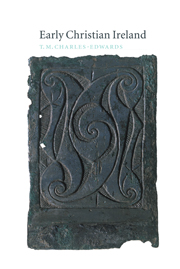Book contents
- Frontmatter
- Contents
- List of maps
- List of tables
- List of figures
- Acknowledgements
- Abbreviations
- A note on pronunciation
- A note on the Chronicle of Ireland
- Introduction
- 1 Ireland in the seventh century: a tour
- 2 Irish society c. 700: I. Communities
- 3 Irish society c. 700: II Social distinctions and moral values
- 4 Ireland and Rome
- 5 Conversion to Christianity
- 6 The organisation of the early Irish Church
- 7 Columba, Iona and Lindisfarne
- 8 Columbanus and his disciples
- 9 The Paschal controversy
- 10 The primatial claims of Armagh, Kildare and Canterbury
- 11 The origins and rise of the Uí Néill
- 12 The kingship of Tara
- 13 The powers of kings
- 14 Conclusion
- Appendix: genealogies and king-lists
- Glossary: Irish and Latin
- Bibliography
- Index
1 - Ireland in the seventh century: a tour
Published online by Cambridge University Press: 11 September 2009
- Frontmatter
- Contents
- List of maps
- List of tables
- List of figures
- Acknowledgements
- Abbreviations
- A note on pronunciation
- A note on the Chronicle of Ireland
- Introduction
- 1 Ireland in the seventh century: a tour
- 2 Irish society c. 700: I. Communities
- 3 Irish society c. 700: II Social distinctions and moral values
- 4 Ireland and Rome
- 5 Conversion to Christianity
- 6 The organisation of the early Irish Church
- 7 Columba, Iona and Lindisfarne
- 8 Columbanus and his disciples
- 9 The Paschal controversy
- 10 The primatial claims of Armagh, Kildare and Canterbury
- 11 The origins and rise of the Uí Néill
- 12 The kingship of Tara
- 13 The powers of kings
- 14 Conclusion
- Appendix: genealogies and king-lists
- Glossary: Irish and Latin
- Bibliography
- Index
Summary
In the 640s, Agilbert, a Frank who was to end his days as bishop of Paris, lived for some years as a student in Ireland. His visit is striking because in 640 the Franks were still the most powerful people in Western Europe, while Ireland was considered to lie at the end of the world. Yet he wasonly the first of several foreign visitors to Ireland to be mentioned by the Northumbrian English historian Bede.
Agilbert's journey to Ireland was a consequence of an earlier journey in the reverse direction, from Ireland to Francia: a pilgrimage by a Leinsterman, Columban us. This pilgrimage, or peregrinatio, was not a pilgrimage in the sense of a visit to some shrine, such as to the Holy Places in Palestine, or to the tomb of St Peter in Rome or to St James of Compostela; it was not a journey to a holy place where prayers were said and the pilgrim then returned home. Such pilgrimages were common in the early Middle Ages, but Columbanus’ was not one of them. His was a journey with no return, a journey not to a shrine, but away from family and native land. The result was the foundation of three monasteries in northern Burgundy: Annegray, Lux euil and Fontaine.
- Type
- Chapter
- Information
- Early Christian Ireland , pp. 8 - 67Publisher: Cambridge University PressPrint publication year: 2000



